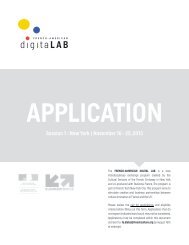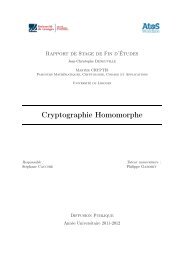REX
BD16_REX
BD16_REX
You also want an ePaper? Increase the reach of your titles
YUMPU automatically turns print PDFs into web optimized ePapers that Google loves.
Retours d’expériences Big Data en entreprise<br />
STEPS TO SUCCESS<br />
In March 2005, Oxford University Press selected Mark Logic’s XML content server as the foundation technology<br />
upon which to build its new product platform. MarkLogic Server would provide three things:<br />
• A flexible database for the content that OUP would include in AASC and in all future platform-based projects. As<br />
a database, it was specifically designed for the structured XML documents that constituted OUP’s content.<br />
• A powerful search engine that would enable customized searching on a per-product basis<br />
• The ability to use the XQuery language, a W3C standard that OUP considers to be cutting-edge<br />
Not long after selecting MarkLogic as the basis for its platform, Oxford University Press chose Boston- based Interactive<br />
Factory (IFactory) to build the platform and the AASC product. Having worked with IFactory on the Oxford<br />
Dictionary of National Biography (www.oxforddnb.com), OUP was confident in its ability to understand the complex<br />
requirements of the platform and the product. The design phases of both projects began in June 2005.<br />
Meanwhile, OUP was assembling the content for the African American Studies Center. The content took a variety<br />
of paths into the product:<br />
• The core content from the main African American encyclopedias needed to be tagged into XML.<br />
• Other content was used from other products such as Oxford Reference Online and Grove Music Online; this<br />
content required very little work to incorporate.<br />
• Some content needed to be created specifically for the site. This set included articles and features as well as<br />
certain metadata regarding the rest of the content on the site.<br />
By late fall, OUP had solid designs for the product and the platform. The company also had the bulk of the content<br />
created and detailed plans for the remaining elements. With this, the development phase with IFactory began.<br />
The platform was released and tested in an Alpha site in January, and a Beta site in March. The AASC product was<br />
launched in late April, in time to market it for the summer academic library season.<br />
The teams responsible for the project consisted of a core group of four people from OUP and an additional four<br />
from IFactory. Those teams expanded, however, to include other people and roles when the project demanded it.<br />
In all, OUP spent two years on this project. The first year was spent assessing opportunities and needs. Once<br />
MarkLogic and IFactory were chosen, the site and platform were designed and developed in less than eleven<br />
months. The schedule was aggressive, but ultimately successful.<br />
Figure 1: Publishing Platform and AASC Project Timeline<br />
IMPACT OF THE RESULTS<br />
The product implemented on the platform looks similar to existing projects that were done the old way. This is a<br />
testament to the fact that OUP met its goal of not having the platform limit the product’s design or functionality. The<br />
first reviews of AASC have been extraordinarily positive.<br />
The impact of the platform will be felt more significantly on future projects. For one thing, the new project team<br />
now has a resilient new platform on which to work. This should enable OUP to diminish the duration and cost of<br />
implementing new projects. Under the right circumstances (i.e. in the development of new Studies Centers), the<br />
time taken to develop new products could drop from 10 – 12 months to 4 – 6 months.<br />
Document réalisé par la Société Corp Events - Janvier 2015<br />
52







